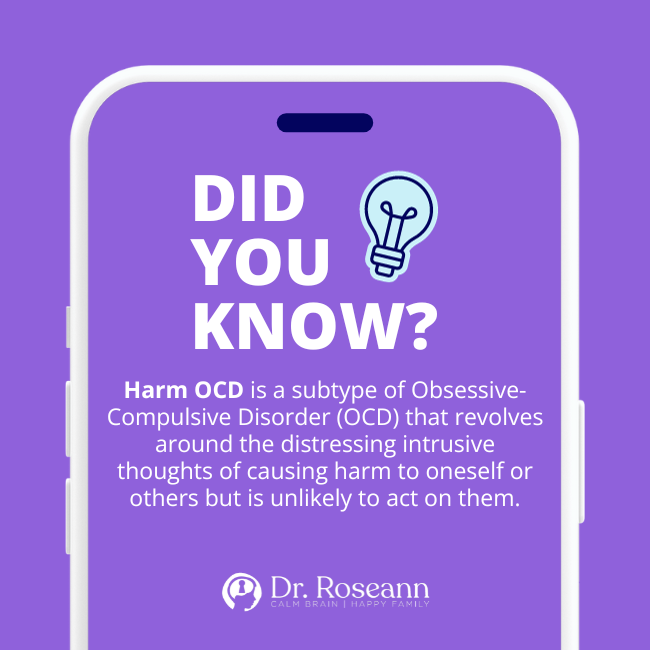There is actually a form of OCD that causes one to have unwanted violent thoughts toward oneself or others and this can be especially frightening for a child and their parents.
Harm OCD is a subtype of Obsessive-Compulsive Disorder (OCD) that revolves around the distressing intrusive thoughts of causing harm to oneself or others. These unwanted violent thoughts can be particularly challenging for individuals experiencing this form of OCD.
Those with Harm OCD often grapple with obsessive thoughts that are often vivid and disturbing. The thoughts related to OCD include fears of using sharp objects, aggressiveness, or violence.
Common Harm OCD Compulsions, Obsessions and Avoidance Behaviors

A common misconception is that individuals experiencing Harm OCD are more likely to act on these thoughts, but in reality, a Harm OCD sufferer is as unlikely to act on these thoughts as anyone else.
Due to the internal nature of OCD and the lack of understanding about how OCD manifests, Individuals who experience these types of intrusive thoughts may be misdiagnosed as depressed or psychotic. I have worked with many children and teens whose Harm OCD landed them in a psychiatric facility because the professionals missed that it was intrusive thoughts.
Obviously, if one has a plan and true feelings of self-harm, then the highest level of care is required. Parents should be especially concerned about repeated statements of harm, if there is a plan, or they are in a high risk category. You can listen to my podcast episode on suicide to learn more.
List of Harm OCD Symptoms:

Unwanted Violent Thoughts
Unwanted violent thoughts are prevalent in Harm OCD. Their intrusive nature distinguishes them, as they enter the individual's mind involuntarily, causing a sense of powerlessness and discomfort.
While individuals with Harm OCD are unlikely to act on these thoughts because they conflict with their true values and intentions, they may induce a heightened fear of losing control and acting inappropriately. These bad thoughts are persistent and impactful. They can affect daily functioning and cause children and teens to engage in compulsions and avoidance behaviors.
Thoughts of Harm to Others
This symptom involves distressing and intrusive OCD thoughts, images, or ideas wherein individuals find themselves contemplating the possibility of causing harm to those around them. Such thoughts are involuntary, often entering the mind without invitation and causing significant discomfort.
The content of these thoughts typically revolves around scenarios in which the child becomes the unintentional perpetrator of harm, challenging their core values and moral beliefs. The specificity of these thoughts can intensify the emotional distress they experience though they conflict with their true intentions and desires.
The fear of being capable of causing harm to others, even against one's own will, highlights the complexity and emotional strain associated with this aspect of Harm OCD (Hershfield & Grayson, 2018).
Fear of Committing Violent Acts
The fear of committing violent acts is a significant facet of Harm OCD. It often involves distressing and intrusive thoughts that evoke an intense apprehension regarding the potential to engage in violent behaviors.
Individuals grappling with this aspect of Harm OCD often experience a heightened sense of anxiety stemming from the fear that they might lose control over their actions and perpetrate harm, directly contradicting their true intentions and moral compass.
These OCD fears are characterized by their unwelcome and involuntary intrusion into the individual's mind which intensifies their emotional distress. The fear of committing violent acts may manifest in scenarios where the individual envisions themselves carrying out harmful actions, often with a heightened focus on the potential consequences.
Checking Behaviors
A person with Harm OCD involves repetitive actions of checking behaviors to gain reassurance and alleviate anxiety associated with distressing thoughts of causing harm. These behaviors involve inspecting one's environment, safety checks for potential hazards, repeated verifications of the well-being of loved ones, and health-related checks (Ecker & Gönner, 2008).
Seeking Reassurance
Seeking reassurance is a common compulsion observed in children and teens grappling with Harm OCD. It represents a repetitive behavior driven by the relentless anxiety disorder stemming from intrusive thoughts of causing harm.
This compulsion manifests in the frequent need for external validation or confirmation to alleviate the distress associated with the fear of harming oneself or others. Seeking reassurance may take various forms, including verbal requests for confirmation, repetitive questioning, or seeking constant affirmation from every family member, friend, or other trusted individual.
Children and teens with this OCD seek reassurance to ease the persistent doubts and uncertainties triggered by their intrusive thoughts. However, this seeking behavior offers only temporary relief, as the reassurance becomes a fleeting solution that does not address the underlying anxieties or dispel the distressing thoughts.
Mental Rituals and Reviewing
Mental rituals and reviewing in Harm OCD involve internal compulsive behaviors where individuals engage in repetitive thought patterns. They are also mentally reviewing and analyzing past interactions, forecasting future scenarios, and vividly imagining worst-case outcomes to alleviate anxiety associated with intrusive thoughts of causing harm.
The tendency to ruminate can cause those with OCD to get stuck and fearful of addressing OCD head on. I was recently working with a teen named Thomas who had overcome his Harm OCD but was still plagued by negative rumination. With parent coaching and an emphasis on overcoming anxious avoidance, Thomas was able to get control of his OCD and he is a healthy, happy teen again.
Restriction of Activities
This OCD symptom refers to a behavioral pattern where individuals alter their daily routines, avoid specific situations, withdraw socially, and limit engagement in activities perceived as potentially risky or harmful.
Such compulsive behavior emerges in response to distressing thoughts of causing harm and aims to minimize perceived risks and alleviate associated anxieties. While providing a temporary sense of safety, the restriction of activities reinforces the cycle of anxiety by validating the belief that certain situations pose inherent risks.
Avoidance of Triggers
In Harm OCD, avoidance of triggers reflects a deliberate effort by individuals to evade situations, environments, or stimuli perceived as potential instigators of distressing thoughts related to causing harm.
This behavior aims to minimize the perceived threat and alleviate the intense anxiety associated with intrusive thoughts. Avoidance can manifest in various forms, including steering clear of specific places, limiting social interactions, adjusting daily routines, and avoiding informational sources tied to perceived triggers.
Treatment for Harm OCD
Harm OCD and other types of OCD while challenging, is a manageable mental health disorder. With the right combination of Cognitive Behavioral Therapy (CBT) and Exposure and Response Prevention or ERP Therapy, children and teens can reclaim their lives and find relief from the distressing thoughts that once dominated their existence.
Harm OCD sufferers and their families must seek the help of a mental health professional who specializes in the treatment of OCD. They should be ready to challenge misconceptions and work towards a future where intrusive thoughts no longer dictate the course of one's life.
The BrainBehaviorResetTM Program offers a comprehensive natural solution to treat OCD in children and teens. It also incorporates science-backed solutions such as neurofeedback, PEMF therapy, and magnesium supplementation, which constitute the gold standard treatment for all forms of OCD.
Remember that the use of Selective Serotonin Reuptake Inhibitors should never be the first step to addressing the symptoms of OCD or other mental health conditions. Cognitive-behavioral therapy with exposures, which is called ERP therapy can help manage the intrusive mental images and when combined with other natural solutions, can be an effective treatment plan for OCD and drastically improve your child's quality of life.
Parent Action Steps
☐ Understand the symptoms and treatment options of this type of Obsessive Compulsive Disorder.
☐ Reflect on your child's behavior and learn to recognize the signs and common obsessions.
☐ Create a safe space for your child to share their Harm OCD thoughts and feelings.
☐ Reassure your child that they are not a bad person and that it's the mental illness that's causing these various compulsions.
☐ Consult with an OCD specialist for a thorough assessment and OCD treatment.
☐ Take this OCD Quiz to get personalized treatment for your child.
☐ Use the Solutions Matcher to work 1on1 with Dr. Roseann.
Citations
Ecker, W., & Gönner, S. (2008). Incompleteness and harm avoidance in OCD symptom dimensions. Behaviour Research and Therapy, 46(8), 895–904. https://doi.org/10.1016/j.brat.2008.04.002
Hershfield, J., & Grayson, J. (2018). Overcoming harm OCD: Mindfulness and CBT Tools for Coping with Unwanted Violent Thoughts. New Harbinger Publications.
Dr. Roseann is a mental health expert who frequently is in the media:
- Insider: What is OCD?
- Single Care Controlling the uncontrollable: Living with OCD during a pandemic
- MomsCove How to Help a Child with Anxiety and OCD
- Holistic Counseling Podcast: Effective Treatments for OCD
- Epidemic Answers: Neurofeedback for ADHD, anxiety, OCD and mood
- BCIA: Calming the OCD Brain with Neurofeedback and ERP Therapy
- Hope for Anxiety and OCD: Sudden Onset OCD
Integrative Practitioner: Integrative Approaches to Treating OCD
Are you looking for SOLUTIONS for your struggling child or teen?
Dr. Roseann and her team are all about science-backed solutions, so you are in the right place!
Dr. Roseann is a Children’s Mental Health Expert and Licensed Therapist who has been featured in/on hundreds of media outlets including The Mel Robbins Show, CBS, NBC, PIX11 NYC, Today, FORBES, CNN, The New York Times, The Washington Post, Business Insider, Women’s Day, Healthline, CNET, Parade Magazine and PARENTS. FORBES called her, “A thought leader in children’s mental health.”

She coined the terms, “Re-entry panic syndrome” and “eco-anxiety” and is a frequent contributor to media on mental health.
Dr. Roseann Capanna-Hodge has three decades of experience in working with children, teens and their families with attention-deficit hyperactivity disorder (ADHD), autism, concussion, dyslexia and learning disability, anxiety, Obsessive Compulsive Disorder (OCD), depression and mood disorder, Lyme Disease, and PANS/PANDAS using science-backed natural mental health solutions such as supplements, magnesium, nutrition, QEEG Brain maps, neurofeedback, PEMF, psychotherapy and other non-medication approaches.
She is the author of three bestselling books, It’s Gonna Be OK!: Proven Ways to Improve Your Child's Mental Health, The Teletherapy Toolkit, and Brain Under Attack. Dr. Roseann is known for offering a message of hope through science-endorsed methods that promote a calm brain.
Her trademarked BrainBehaviorResetⓇ Program and It’s Gonna be OK!Ⓡ Podcast has been a cornerstone for thousands of parents facing mental health, behavioral or neurodevelopmental challenges.
She is the founder and director of The Global Institute of Children’s Mental Health, Neurotastic™Brain Formulas and Dr. Roseann Capanna-Hodge, LLC. Dr. Roseann is a Board Certified Neurofeedback (BCN) Practitioner, a Board Member of the Northeast Region Biofeedback Society (NRBS), Certified Integrative Mental Health Professional (CIMHP) and an Amen Clinic Certified Brain Health Coach. She is also a member of The International Lyme Disease and Associated Disease Society (ILADS), The American Psychological Association (APA), Anxiety and Depression Association of America (ADAA) National Association of School Psychologists (NASP), International OCD Foundation (IOCDF).
© Roseann-Capanna-Hodge, LLC 2023










